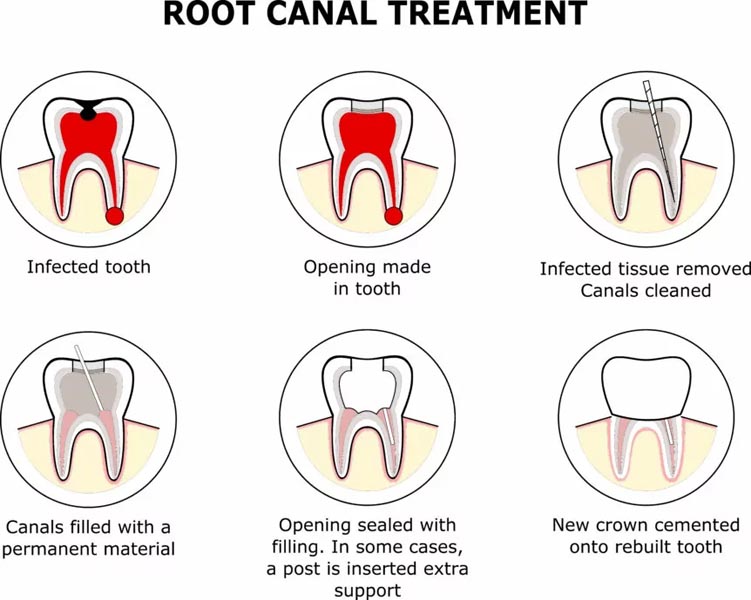Root Canal Therapy Can Save Your Tooth & Surrounding Tissue

The field of dental care often gets a bad reputation because of portrayals in many different media. Visits to the dentists are shown as painful and all-around bad experiences. It doesn’t matter what treatment is shown. One of the treatments with the worst reputation out of all of them is the root canal.
Root canal therapy is the most well-known endodontic treatment. Endodontic treatments main goal is to treat the inside of the tooth. Many people fear this treatment, believing it to be incredibly painful. However, Cosmetic & Family Dentistry of Las Colinas would like to properly educate people on the truth about root canal therapy, quelling the fears and worries of many patients.
The Anatomy of the Tooth
As we mentioned earlier, endodontic treatment is the treatment of the inside of the tooth. Knowing the anatomy of the tooth will help you better understand how a root canal works. The white enamel is the outer most layer of the tooth. Beneath that is a hard layer called the dentin. Underneath both these layers is a soft tissue called the pulp.
The pulp is made up of blood vessels, nerves, and connective tissues. It helps develop all of the hard tissue that surrounds the tooth while it grows. The pulp spreads from the crown to the tip of the roots, connecting to the tissues surround the root. While the pulp is pivotal to the growth and development of teeth, a tooth can survive without it once it has matured, receiving nourishment from the surrounding tissue.
Symptoms
When the pulp inside the tooth becomes inflamed or infected, endodontic treatment is necessary. This inflammation or infection can be caused by several reasons, including a cracked or chipped tooth, a deep cavity, decay, or other serious trauma or tooth injuries. These injuries allow bacteria to infect the pulp. Some symptoms that may indicate infected or inflamed pulp include:
- Severe pain when chewing, biting, and eating
- A chipped or cracked tooth
- Tender or irritated gums
- High sensitivity to hot or cold
- Deep tooth decay
- Darkening gums
When any of these symptoms occur, you should seek treatment immediately.
Root Canal Therapy Process
Usually, root canal therapy can be completed within one or two visits. This endodontic treatment saves the tooth by removing the infected or inflamed pulp, saving the tooth and surrounding tissue. Here is the process of root canal surgery:
- Your tooth will first be numbed with a local anesthetic. Once your tooth is finally numb, a thin protective sheet, called a dental dam, will be placed over the area to isolate the tooth, keeping it dry from excess saliva during the procedure.
- The surgeon will then create an opening in the crown of the tooth. Then they will use very small instruments to remove the diseased pulp from the pulp chamber and root canals. They will also reshape the space to fit filling.
- Once the area has been cleaned and shaped, the endodontist may place medicine in the canal to treat the infection. Then a rubber-like material, called gutta-percha, will be placed in the root canals. Your dentist will use a temporary filling to close the opening in the tooth.
- After a few weeks, you will need to go back to your dentist to receive a permanent crown.
You should not feel pain during the procedure as the tooth will be numbed. However, there may be some soreness following the surgery. Also, important to note, you should not chew or bite with the treated tooth until your dentist has finished restoring it.
Root canal treatments are very misunderstood procedures. Many people view them as being incredibly painful, but the worst pain comes from the tooth being infected prior to the surgery. These endodontic treatments help save your tooth and relieve your pain. Contact Cosmetic & Family Dentistry of Las Colinas if you have any remaining questions surrounding root canals or other dental procedures.
- Awareness16
- Bad Breath1
- Bone Grafting1
- Braces4
- Causes, Symptoms, And Treatments6
- Cavities5
- Chewing Gum1
- Cosmetic Dentistry of Las Colinas15
- COVID-192
- Deep Cleaning7
- Dental Anxiety1
- Dental Bridge2
- Dental Care27
- Dental Cleaning6
- Dental Crown1
- Dental Filling1
- Dental Health24
- Dental Implants6
- Dental Sedation1
- Dental Visit1
- Dental X Ray3
- Floss1
- Gum Dieseases4
- Injury1
- Insurance1
- Invisalign8
- Oral Cancer1
- Oral Hygiene24
- Root Canal9
- Sleep Apnea2
- Tartar1
- Teeth19
- Thanksgiving1
- TMJ1
- Tongue1
- Veneers2
- White Teeth12
Get Your Best Smile With Us
